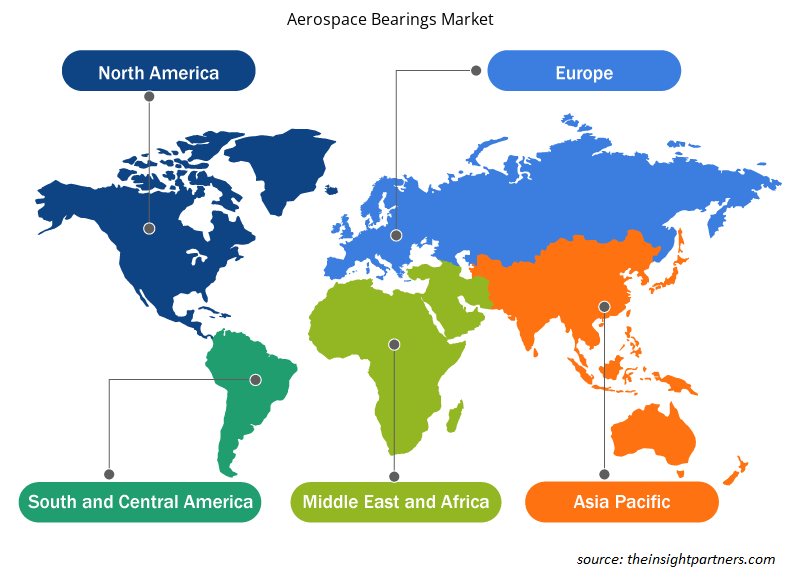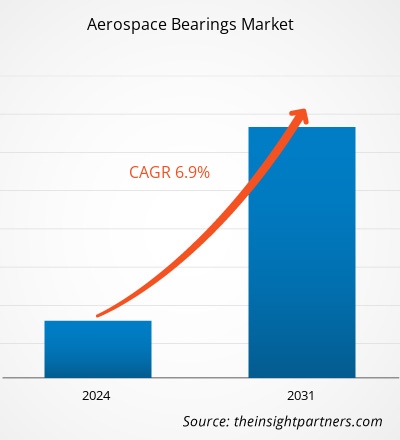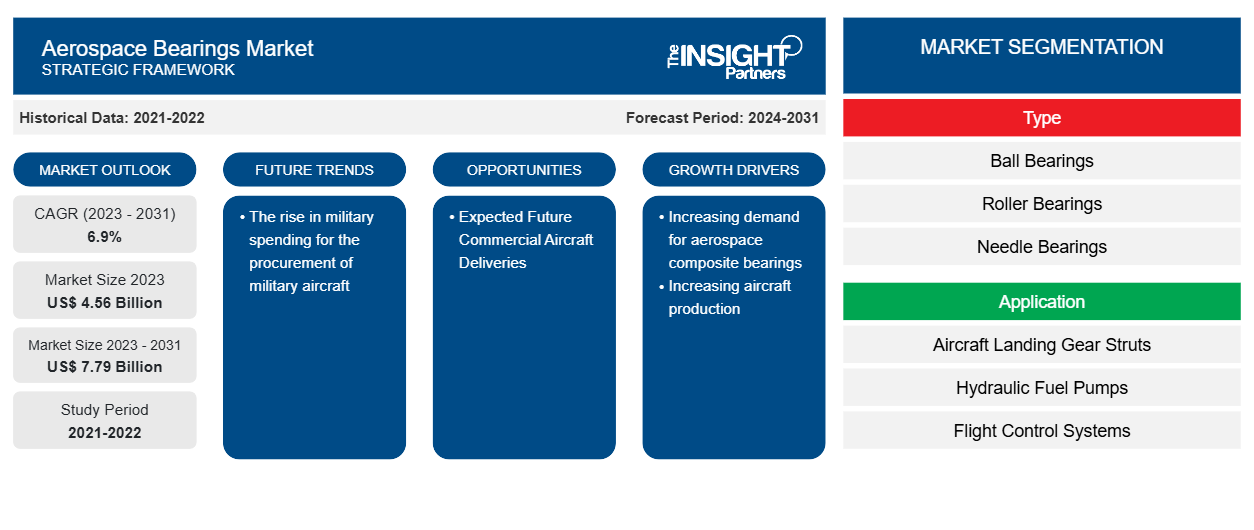Der Markt für Luft- und Raumfahrtlager soll von 4,56 Milliarden US-Dollar im Jahr 2023 auf 7,79 Milliarden US-Dollar im Jahr 2031 anwachsen. Der Markt wird zwischen 2023 und 2031 voraussichtlich eine durchschnittliche jährliche Wachstumsrate von 6,9 % verzeichnen. Die steigenden weltweiten Verteidigungsausgaben für die Beschaffung von Militärflugzeugen dürften ein wichtiger Trend auf dem Markt bleiben.
Marktanalyse für Lager in der Luft- und Raumfahrt
Zu den Lagerherstellern gehören die SKF Group, JTEKT Corporation, GGB, The Timken Company, RBC Bearings Inc., NSK Ltd., Schaeffler AG, NTN Corporation, Kaman Corporation und andere Hersteller. Der Fortschritt in der Lagertechnologie verstärkt die Nachfrage nach Lagern für die Luft- und Raumfahrt. So brachte SKF im September 2021 eine neue Linie von Pendelrollenlagern in Nordamerika auf den Markt. Solche Entwicklungen der Hersteller von Lagern für die Luft- und Raumfahrt treiben also die Marktaussichten voran.
Marktübersicht für Lager für die Luft- und Raumfahrt
Zu den wichtigsten Akteuren im Ökosystem des globalen Marktes für Lager in der Luft- und Raumfahrt zählen Rohstofflieferanten, Hersteller von Lagern in der Luft- und Raumfahrt und Endverbraucher. Der Rohstofflieferant ist der entscheidende Akteur im Ökosystem des Marktes für Lager in der Luft- und Raumfahrt. Die wichtigsten Rohstoffe sind Stahl, Keramik, Kunststoffe und Verbundwerkstoffe, die hauptsächlich zur Herstellung der in Flugzeugen verwendeten Lager verwendet werden. Zu den wichtigsten Rohstofflieferanten zählen TriStar Plastics Corp; Continental Steel & Tube; Johnson Bros. Metal Forming Co; All Metal Sales, Inc. Company; Morgan Advanced Materials; Kineco Limited; UNITECH GROUP; Hexcel Corporation; und andere Akteure. Im Oktober 2021 unterzeichnete ÉireComposites, ein Design-, Fertigungs- und Testunternehmen, einen neuen Multimillionen-Euro-Vertrag mit Spirit AeroSystems zur Lieferung von Strukturkomponenten für Verkehrsflugzeuge und Geschäftsflugzeuge sowie Montageteilen. Darüber hinaus erweiterte Hexcel im Dezember 2020 den langfristigen Liefervertrag mit Safran um fortschrittliche Verbundwerkstoffe für ein breiteres Spektrum kommerzieller Luft- und Raumfahrtanwendungen, darunter Triebwerksgondeln und Flugzeuginnenräume. Daher stärken solche wachsenden Initiativen der Rohstofflieferanten die Flugzeugproduktion, was das Marktwachstum vorantreibt.
Passen Sie diesen Bericht Ihren Anforderungen an
Sie erhalten kostenlos individuelle Anpassungen an jedem Bericht, einschließlich Teilen dieses Berichts oder einer Analyse auf Länderebene, eines Excel-Datenpakets sowie tolle Angebote und Rabatte für Start-ups und Universitäten.
-
Holen Sie sich die wichtigsten Markttrends aus diesem Bericht.Dieses KOSTENLOSE Beispiel umfasst eine Datenanalyse von Markttrends bis hin zu Schätzungen und Prognosen.
Treiber und Chancen auf dem Markt für Gleitlager in der Luft- und Raumfahrt
Flugzeugproduktion treibt das Marktwachstum an
Laut Angaben auf der Website des Unternehmens lieferte Airbus in den Jahren 2021, 2022 und 2023 jeweils 611, 661 und 735 Verkehrsflugzeuge aus. Ebenso lieferte Boeing in den Jahren 2021, 2022 und 2023 jeweils rund 340, 480 und 528 Verkehrsflugzeuge aus. Dies zeigt einen Anstieg der Flugzeugproduktion und -lieferungen der beiden weltweit größten Flugzeughersteller, was zu einer neuen Nachfrage nach Flugzeugkomponenten und -unterkomponenten einschließlich Lagern für verschiedene Flugzeuganwendungen führt.
Die zunehmenden Initiativen zur Erweiterung der Produktionsstandorte steigern die Nachfrage nach Komponenten und Ausrüstung für Flugzeuge, was das Marktwachstum weiter ankurbelt. So eröffnete Bombardier im Mai 2024 sein neues Produktionszentrum für die globale Flugzeugmontage im Wert von 500 Millionen US-Dollar in Toronto Pearson, Kanada. Solche Entwicklungen treiben das Wachstum des Marktes für Luft- und Raumfahrtlager weltweit voran.
Zukünftige Auslieferungen von Verkehrsflugzeugen und allgemeinen Flugzeugen
Es wird erwartet, dass der Anstieg der Flugzeugauslieferungen die potenzielle Nachfrage nach passgenauen Lagern für die Luft- und Raumfahrt aufrechterhalten und das Marktwachstum im Prognosezeitraum antreiben wird. So meldete Airbus im März 2022 die konsolidierten Finanzergebnisse für das erste Quartal und prognostizierte ein starkes Wachstum der Nachfrage nach Verkehrsflugzeugen, angetrieben von der A320-Familie. Das Unternehmen plant, die Produktionsraten der A320-Familie im Jahr 2025 auf 75 Flugzeuge pro Monat zu steigern. Darüber hinaus hat Boeing rund 300 Bestellungen für die neue Generation der 777-Familie erhalten und im April 2022 die Auslieferung seines ersten 777X-Flugzeugs auf 2025 verschoben. Boeing rechnet in diesem Zeitraum mit der Produktion von 25.680 neuen Schmalrumpfflugzeugen mit einem Marktwert von 4,4 Billionen US-Dollar, während Bombardier für die nächsten 20 Jahre die Auslieferung von 22.000 Geschäftsflugzeugen prognostiziert. Airbus prognostizierte im Jahr 2024 einen Bedarf von über 42.000 neuen Passagier- und Frachtflugzeugen bis 2042. Die steigende Zahl der ausgelieferten Flugzeuge führt somit zu einer Steigerung der Flugzeugproduktion, was wiederum die Nachfrage nach Lagern für die Luft- und Raumfahrt weiter steigert und das Marktwachstum im Prognosezeitraum ankurbelt.
Segmentierungsanalyse des Marktberichts zu Lagern für die Luft- und Raumfahrt
Wichtige Segmente, die zur Ableitung der Marktanalyse für Luft- und Raumfahrtlager beigetragen haben, sind Typ, Anwendung, Material und Flugzeugtyp.
- Der Markt für Luft- und Raumfahrtlager ist nach Typ in Kugellager, Rollenlager, Nadellager, Axiallager und andere unterteilt. Das Kugellagersegment hatte im Jahr 2023 einen größeren Marktanteil.
- Basierend auf der Anwendung ist der Markt für Luft- und Raumfahrtlager in Flugzeugfahrwerksstreben, hydraulische Kraftstoffpumpen, Flugsteuerungssysteme und andere unterteilt. Das Segment Flugsteuerungssysteme hatte im Jahr 2023 einen größeren Marktanteil.
- Basierend auf dem Material ist der Markt für Luft- und Raumfahrtlager in Edelstahl, faserverstärkte Verbundwerkstoffe, technische Kunststoffe und andere unterteilt. Das Edelstahlsegment hatte im Jahr 2023 einen größeren Marktanteil.
- Basierend auf dem Flugzeugtyp ist der Markt für Luft- und Raumfahrtlager in Starrflügel- und Drehflügelflugzeuge unterteilt. Das Starrflügelsegment hatte im Jahr 2023 einen größeren Marktanteil.
Marktanteilsanalyse für Luft- und Raumfahrtlager nach Geografie
Der geografische Umfang des Marktberichts für Luft- und Raumfahrtlager ist hauptsächlich in fünf Regionen unterteilt: Nordamerika, Europa, Asien-Pazifik, Naher Osten und Afrika sowie Südamerika.
Nordamerika dominierte den Markt im Jahr 2023, gefolgt von Europa und dem asiatisch-pazifischen Raum. Darüber hinaus dürfte der asiatisch-pazifische Raum in den kommenden Jahren die höchste durchschnittliche jährliche Wachstumsrate verzeichnen. Einer der Hauptfaktoren, die den Marktanbietern im asiatisch-pazifischen Raum neue Chancen eröffnen dürften, ist die erwartete Auslieferung von Verkehrs- und Militärflugzeugen in der gesamten Region in den kommenden Jahren. So werden beispielsweise laut den Prognosen von Airbus bis Ende 2042 voraussichtlich mehr als 18.800 Verkehrsflugzeuge im asiatisch-pazifischen Raum ausgeliefert. Dieser Faktor dürfte in den kommenden Jahren neue Chancen für Lager in der Luft- und Raumfahrt schaffen.
Regionale Einblicke in den Markt für Luft- und Raumfahrtlager
Die regionalen Trends und Faktoren, die den Markt für Luft- und Raumfahrtlager im Prognosezeitraum beeinflussen, wurden von den Analysten von Insight Partners ausführlich erläutert. In diesem Abschnitt werden auch die Marktsegmente und die Geografie von Luft- und Raumfahrtlagern in Nordamerika, Europa, im asiatisch-pazifischen Raum, im Nahen Osten und Afrika sowie in Süd- und Mittelamerika erörtert.

- Erhalten Sie regionale Daten zum Markt für Lager für die Luft- und Raumfahrt
Umfang des Marktberichts über Lager für die Luft- und Raumfahrt
| Berichtsattribut | Details |
|---|---|
| Marktgröße im Jahr 2023 | 4,56 Milliarden US-Dollar |
| Marktgröße bis 2031 | 7,79 Milliarden US-Dollar |
| Globale CAGR (2023 - 2031) | 6,9 % |
| Historische Daten | 2021-2022 |
| Prognosezeitraum | 2024–2031 |
| Abgedeckte Segmente |
Nach Typ
|
| Abgedeckte Regionen und Länder |
Nordamerika
|
| Marktführer und wichtige Unternehmensprofile |
|
Marktteilnehmerdichte: Der Einfluss auf die Geschäftsdynamik
Der Markt für Luft- und Raumfahrtlager wächst rasant. Dies wird durch die steigende Nachfrage der Endnutzer aufgrund von Faktoren wie sich entwickelnden Verbraucherpräferenzen, technologischen Fortschritten und einem größeren Bewusstsein für die Vorteile des Produkts vorangetrieben. Mit der steigenden Nachfrage erweitern Unternehmen ihr Angebot, entwickeln Innovationen, um die Bedürfnisse der Verbraucher zu erfüllen, und nutzen neue Trends, was das Marktwachstum weiter ankurbelt.
Die Marktteilnehmerdichte bezieht sich auf die Verteilung der Firmen oder Unternehmen, die in einem bestimmten Markt oder einer bestimmten Branche tätig sind. Sie gibt an, wie viele Wettbewerber (Marktteilnehmer) in einem bestimmten Marktraum im Verhältnis zu seiner Größe oder seinem gesamten Marktwert präsent sind.
Die wichtigsten auf dem Markt für Gleitlager für die Luft- und Raumfahrt tätigen Unternehmen sind:
- AST Lager
- GGB
- JTEKT Corporation
- Accurate Bushing Company
- MinebeaMitsumi Inc.
Haftungsausschluss : Die oben aufgeführten Unternehmen sind nicht in einer bestimmten Reihenfolge aufgeführt.

- Überblick über die wichtigsten Akteure auf dem Markt für Lager für die Luft- und Raumfahrt
Neuigkeiten und aktuelle Entwicklungen zum Markt für Lager in der Luft- und Raumfahrt
Der Markt für Lager für die Luft- und Raumfahrt wird durch die Erhebung qualitativer und quantitativer Daten nach Primär- und Sekundärforschung bewertet, die wichtige Unternehmensveröffentlichungen, Verbandsdaten und Datenbanken umfasst. Nachfolgend sind einige der Entwicklungen auf dem Markt für Lager für die Luft- und Raumfahrt aufgeführt:
- Cablecraft Motion Controls („Cablecraft“), ein Portfoliounternehmen der Torque Capital Group, gab heute bekannt, dass es den Kauf von Radial Bearing Corp. („Radial“), einem führenden Entwickler und Hersteller von Gelenkköpfen und Gelenklagern, abgeschlossen hat. Radial mit Sitz in Danbury, Connecticut, hat eine lange Tradition in der Bereitstellung technischer Lösungen für die Luft- und Raumfahrt, Verteidigung und Industriemärkte. (Quelle: Cablecraft Motion Controls, Pressemitteilung, Februar 2024)
Schaeffler wird Rolls-Royce langfristig mit modernsten Produktionstechnologien und Fertigungsverfahren unterstützen. Der Auftrag umfasst vor allem die Produktion und Entwicklung von Triebwerkswälzlagersystemen für das Marktsegment der Großraumflugzeuge und Businessjets (Quelle: Schaeffler, Pressemitteilung, April 2022)
Marktbericht zu Gleitlagern für die Luft- und Raumfahrt
Der Bericht „Marktgröße und Prognose für Lager in der Luft- und Raumfahrt (2021–2031)“ bietet eine detaillierte Analyse des Marktes, die die folgenden Bereiche abdeckt:
- Marktgröße und Prognose für Lager in der Luft- und Raumfahrt auf globaler, regionaler und Länderebene für alle wichtigen Marktsegmente, die im Rahmen des Berichts abgedeckt sind
- Markttrends für Lager in der Luft- und Raumfahrt sowie Marktdynamik wie Treiber, Einschränkungen und wichtige Chancen
- Detaillierte Porter-Fünf-Kräfte-Analyse
- Marktanalyse für Lager in der Luft- und Raumfahrt, die wichtige Markttrends, globale und regionale Rahmenbedingungen, wichtige Akteure, Vorschriften und aktuelle Marktentwicklungen umfasst
- Branchenlandschaft und Wettbewerbsanalyse, die die Marktkonzentration, Heatmap-Analyse, prominente Akteure und aktuelle Entwicklungen auf dem Markt für Lager für die Luft- und Raumfahrt abdeckt
- Detaillierte Firmenprofile
- Historische Analyse (2 Jahre), Basisjahr, Prognose (7 Jahre) mit CAGR
- PEST- und SWOT-Analyse
- Marktgröße Wert/Volumen – Global, Regional, Land
- Branchen- und Wettbewerbslandschaft
- Excel-Datensatz
Aktuelle Berichte
Erfahrungsberichte
Grund zum Kauf
- Fundierte Entscheidungsfindung
- Marktdynamik verstehen
- Wettbewerbsanalyse
- Kundeneinblicke
- Marktprognosen
- Risikominimierung
- Strategische Planung
- Investitionsbegründung
- Identifizierung neuer Märkte
- Verbesserung von Marketingstrategien
- Steigerung der Betriebseffizienz
- Anpassung an regulatorische Trends























 Kostenlose Probe anfordern für - Markt für Luft- und Raumfahrtlager
Kostenlose Probe anfordern für - Markt für Luft- und Raumfahrtlager